How to Calculate Keyword Difficulty? A Step-by-Step Guide
Keyword research plays a crucial role in SEO. Targeting the right keywords generates traffic, leads, and revenue for businesses. The right keyword search approach saves time, money, and effort for SEO. Let’s discuss how to measure keyword difficulty for your website’s SEO.

Deepak Sharma
SEO Specialist
April 21, 2025 | 6 min. read

Table of the content
Overview of keyword difficulty and its role in SEO.
Search Engine Optimization (SEO) is the practice of ranking websites on SERPs. Finding the right keywords related to the website is a tough game. Keyword difficulty is a factor that need to consider while keyword research. Analyzing the keyword difficulty helps to find the productive keywords.
Before targeting keywords, greatest businesses understand the importance of keyword difficulty. They follow the right SEO approach and gain more revenue with less effort. But how they do that? In this blog we discuss step by step how to analysis keyword difficulty.
Understanding Keyword Difficulty
What is Keyword Difficulty?
It is the SEO matrix from 0 to 100 score, understanding how a keyword is difficult to rank. Every keyword comes in a 0 to 100 scale matrix that tells the difficulty level. A low score means low competition and a Higher score indicates higher competition.
How does keyword difficulty affect search rankings?
The difficulty level of a keyword tells us how challenging it is to rank it on SERP. A high search difficulty means we need extra SEO efforts to rank a keyword. It takes time and resources to get results.
Businesses know that they spend money and resources to get the expected results. Low-competition keywords rank without much SEO effort. However, choosing the right keywords is a challenging task.
Difference between high, medium, and low keyword difficulty scores.
As we have read, keyword difficulty is a scale metric from 0 to 100. Keywords that are easy to rank easily fall in the 0 to 30 level. Their search volume may be low but the long-term keywords are result-oriented. These keywords are most important for new websites.

Medium KD keywords fall between 31 to 60 levels. Their search volume is medium and hence the competition is medium. These keywords are perfect for medium-sized businesses whose website authority is good. It is a bit difficult for new websites to target such keywords.
A high keyword difficulty score is usually more than 60 or 70. These keywords indicate tough competition. Big companies rank on these keywords. These are mostly short-tail keywords and make ranking difficult. This requires a significant investment of time and money in SEO.
Why Keyword Difficulty Matters in SEO
Find the Right Keywords for Better Ranking Chances
When the competition is low, the chances of keywords getting ranked at the top increases. With continuous SEO efforts, keywords start getting ranked at the top. This increases the presence of the website and traffic starts coming on the website.
Prevents wasted efforts on overly competitive keywords
Keyword research is a complicated task. Creating a list of the right keywords for a business is challenging. It tests your understanding as well as your time. So use your resources wisely. Don’t waste too much time in choosing difficult keywords. Ignore difficult keywords and focus on keywords with low competitors.
It is difficult to rank keywords with high competition at the top. Competitors are already ranking on the search engine result page. We can rank at the top only by doing better SEO practices than them. For this, it is very important to have time, money, and resources. By doing SEO practices for a long time, keywords with high keyword difficulty rank.
Aligned keyword difficulty with content marketing goals
Do in-depth keyword research for your business. Sort out keywords according to the needs of the target audience and business goals. These keywords will give you a roadmap to create the right content. Optimize content according to users’ pain points by addressing those keywords. Find the keywords that address user intent.
Here are some points you must know:
Identify your business objectives. For example, brand presence, sales, revenue, lead generation, building authority, or any other.
Identify the right audience and understand their search behavior, needs, wants, and interests.
To measure the success of your SEO efforts, determine key performance indicators (KPIs). What results do you want in a certain time? Examples: keyword rankings, website traffic, leads, user engagement, and more.
Factors That Influence Keyword Difficulty
Many factors influence keyword difficulty. These factors tell us how difficult it can be to rank a keyword. Let us understand these factors one by one.
Competition Level
There are many SEO factors in website ranking. One of these is the level of competition which plays an important role in the success of SEO. Keyword difficulty indicates the expected competition level of a particular keyword. Which can be low, medium, or high. This matrix helps in finding the appropriate keywords that align with the SEO strategy.
Keyword Relevancy
Find keywords that are related to your business objectives. Know what your target audience is searching for related to your business. What is their demand, and intent, and what kind of information users are looking for? Keywords that represent your business’s services or products will be productive keywords.
Search volume
Search volume is also a crucial factor in the SEO growth. It tells us how many people are searching for a particular keyword on a search engine each month. It shows the popularity of keywords and their traffic. From this matrix, it becomes clear, how much traffic can come if the keywords are ranked at the top. Search volume and keyword difficulty play a crucial role in keyword research.
Backlink Strength
Analyzing the competitor’s backlinks is a key factor of keyword difficulty. It plays a crucial role in determining how a keyword is hard to outrank competitors. Quality backlinks build authority and brand presence of the website. Let’s explore it.
How to check competitors' backlinks?
Many SEO tools help to determine the backlinks of competitors. SEMrush, Ahref, and MOZ are popular tools. Simple Insert the URL of the competitor’s website and view the report of a list of backlinks. These tools provide filters to determine the following matrix.
Check the number of backlinks.
Analysis Domain Authority (DA) and Page Authority where competitors build the backlinks.
Check the versatility of backlinks such as blogs, profiles, forums, and more.
Check the follow or no-follow and anchor text of backlinks.
Tips – Analysis of the anchor text of target keywords from the report. Filter out the industry-specific high authority sites where backlinks are created. If there are a large number of websites linking to top-ranked pages, it shows high competition. Avoid spammy backlinks.
SERP Landscape
Maximum organic traffic comes from the top 3 results of the Search Engine Result Page. But now, it makes it more difficult to rank on top due to SERP features.
There are features like AI Overviews, featured snippets, local packs, and videos. These features help users to find the right result based on their query. For the websites, it increases the difficulty label to rank on top
How does difficulty level help to position keywords at the top of search results? The solution is to match keyword difficulty with search volume. Low keyword difficulty and high search volume make a good SEO strategy.
The most productive keywords include two main factors. These are low keyword difficulty, and high search volume. Keep this combination in mind and choose the right keywords.
How to find Keyword Difficulty?
In the SEO game, every business wants to rank on top in the Search Engine Result Pages (SERPs). Finding a list of keywords that are easy to rank and generate revenue is a tough task.
There are many SEO tools available in the market that help in analyzing the difficulty. For example: Google keyword Planner, SEMrush, and Ahref are two famous tools.
There are two methods to determine the difficulty level of a keyword: manual and paid tools. Let’s read on.
How to determine keyword difficulty manually?
Step 1:
On a target keyword, the SERP shows top-ranking websites. The result includes SERP features, top pages, videos, backlinks, and more.
Step 2:
“On a target keyword” Identify top ranking pages on SERP result. Analyze the content of these websites’ pages. Assess the quality and type of the backlinks. The content may include text, videos, images, or images with alt tags.
Step 3:
Examine the backlink profiles that appear on top of the SERP. Assess the quality and type of the backlinks. Also, examine the domain authority of the websites where the backlinks were created. High DA sites increase the difficulty level.
Step 4:
Also, examine the SERP features. It also makes competition harder. Examine the SERP features that appear on top while searching for the target keywords. These can be AI overviews, feature snippets, knowledge panels, or local packs.
Step 5:
Now compare your website with this assessment. Examine where your website stands. Check your domain authority, content quality, and backlink profiles. This will help you analyze keyword difficulty.
Top Paid Tools to Measure Keyword Difficulty
The famous tools are Ahref, SEMrush, Moz, and Keyword Planner. Different tools use different matrices to check keyword difficulty. When you check a keyword on these tools you must know as folllow:
Ahref
This tool calculates the number of backlinks that are built on high Authority sites. High-quality backlinks mean high keyword difficulty.
SEMrush
This tool uses different matrices. To calculate, SEMrush focuses on four SEO factors.
Domain Authority
Referral Domains
Backlink Quality on SERP
Ratio of Do-follow and No-follow backlinks
By analyzing this matrix, shows the difficulty level of a keyword.
Moz
Moz is also a powerful tool that helps to analyze keyword difficulty. But it uses some different matrices as follows:
Total number of internal links vs home page
Check Domain Authority (DA) as well as Page Authority (PA)
Number of Quality backlinks or Top Ranking Pages on SERP
Google Keyword Planner
This is a free tool provided by Google. It does not show any keyword difficulty level of a page but helps this. It shows search volume as well as competition level. By comparing both matrices, you can understand the difficulty level of keywords.
I used all tools in my career but I recommend SEMrush tools. I have been using this tool for the last 10 years and it gives me the right analysis always. I love the easy interface of these tools.
Choosing Keywords Based on Difficulty Score
Finding the right keywords gives SEO results. It will be a challenging task for SEO experts. Using paid tools saves time and effort. But if you find keywords manually, which matrix do you consider? Let’s discuss this.
Difficulty Level
It tells the scale from 0 to 100. Below 20 are low-competition keywords. 20 to 30 is medium, and above 30 is high-competition keywords. The best practice is to choose low-competition keywords that are easy to rank.
Search Volume
It is defined as the number of users searching for a keyword per month. Short-tail keywords, whose length is 2 to 3 words, have a high search volume. On the other hand, long-tail keywords, whose length is more than 3 words, have less search volume.
Search Intent
It is the query a user enters on a search engine. It simply tells the behavior of a user behind the search.
Now, how do you find the right keyword?
First, find keywords with low competitors between 0 to 20 levels. Second, the search volume must be as high as possible. Third, understand the intent of the keywords. Check manually by putting a keyword one by one on a search engine and check the result. Check if it matches your findings or not.
By following these three matrices, find high-potential keywords with low difficulty levels.
How to Calculate Keyword Difficulty Using SEO Tools
Here we discuss the top SEO tools that help in calculating KD in minutes. As we above analyze the matrix but now considering how we check the difficulty level in that.
Ahref
This is one of the most popular and effective tools. This tool provides “Free Keyword Difficulty Checker” tools. Here is step by step guide to calculating KD in it.
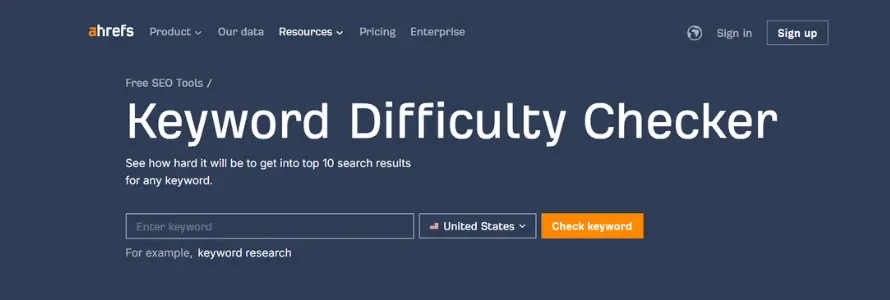
Open this link: https://ahrefs.com/keyword-difficulty/
Create an account on the SEMrush website. Visit on “Keyword Overview” section on the left menu.
Enter the Keywords. Select the country in which you determine the competition level. Next is to click on “Check Keyword”. It shows the result as follows.
SEMrush
SEMrush is the largest AI-powered keyword checker with extra features. Where you can enter any domain for personalized data. You need to by paid plan to use this tool. Here is step by step guide.
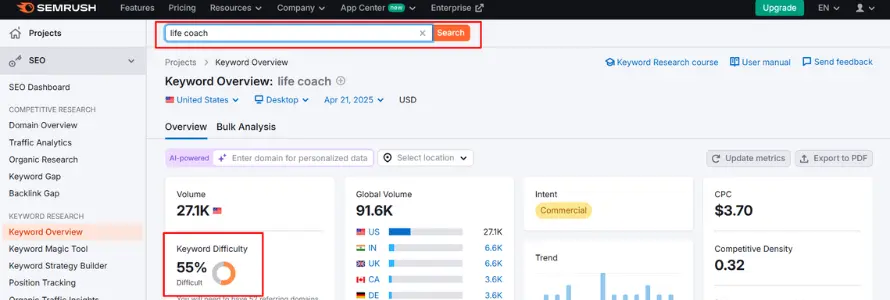
Open this link: https://www.semruh.com/analytics/keywordoverview/
Enter the keywords. Select location, and sub-location and click on search.
Moz
It is also a free-to-use AI-powered tool. Follow these steps to check KD in this tool.
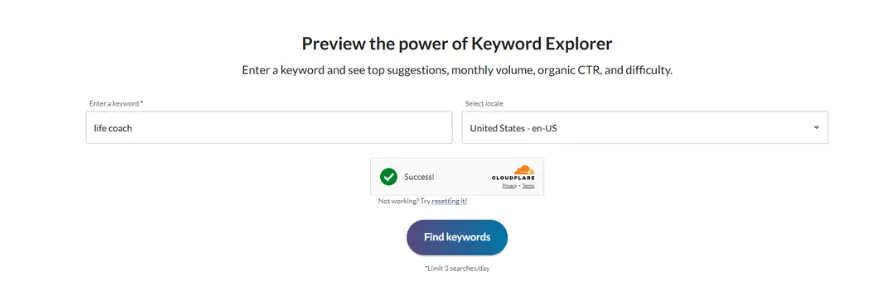
Open this link: https://moz.com/explorer
Enter keywords, select location, and click on “Find Keyword”.
Keyword Planner
You just need to create an account on Google Ads to access this tool. This is a free tools that help to understand the search volume as well as the competition. Here is a step-by-step guide.
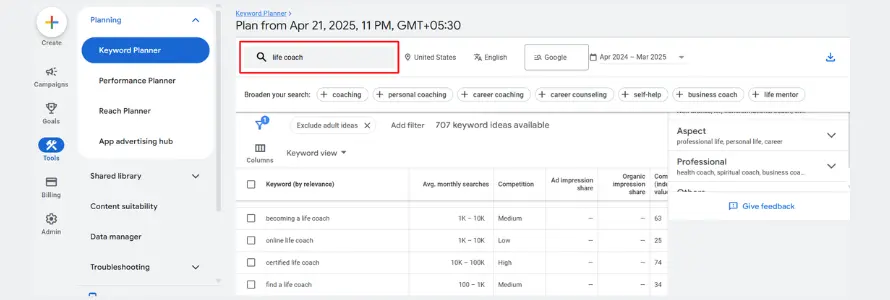
Open this link: https://business.google.com/in/ad-tools/keyword-planner/
Create an account on Google Ads. After opening the window of the keyword planner, click on “Discover new keywords”
Enter keywords. Here is also an option where you enter a site to filter unrelated keywords. and click on “Get results”. You can see the result below.
Ubersuggest
This is also a Free Keyword Research Tool provided by Neil Patel. Here is a step-by-step procedure to calculate keyword difficulty in Ubersuggest.
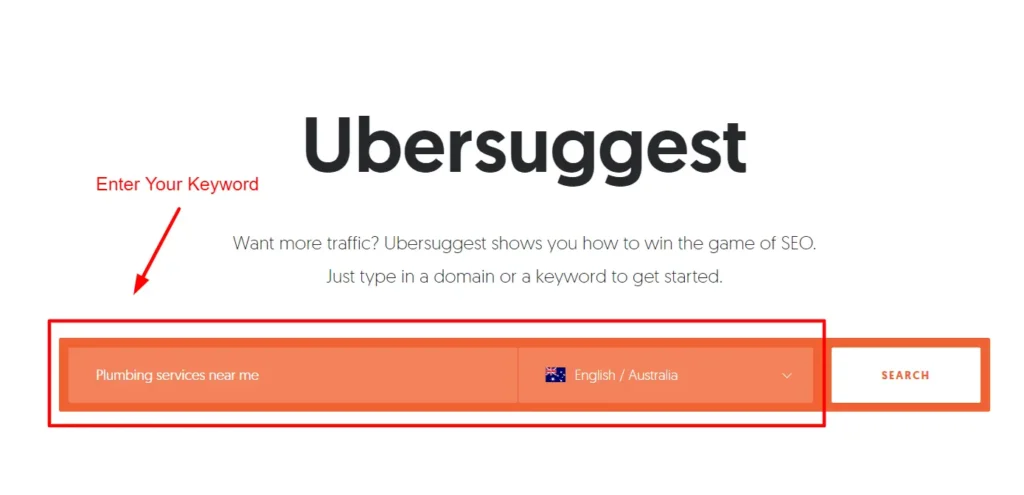
1. Open this link: https://neilpatel.com/ubersuggest/
2. Enter a domain or a keyword, select a location, and click on the “Search” button.
It shows the result as below:
Common Keyword Difficulty Mistakes & How to Avoid Them
Right keywords are those queries that your target audience is searching for. The search intent of the right audience is your potential keywords. After that, analyze your website content and optimize it according to the keywords. But the real problem arises when we identify the right keywords for our website. There are many such factors that we ignore while doing keyword research. Let’s talk about these:
Competitors
Right keywords are those queries that your target audience is searching for. The search intent of the right audience is your potential keywords. After that, analyze your website content and optimize it according to the keywords. But the real problem arises when we identify the right keywords for our website. There are many such factors that we ignore while doing keyword research. Let’s talk about these:
keyword Research
Find the right keywords by using Ahref or SEMrush tool. This tool will show you the top-ranked pages on SERP. These will either be your competitors or their backlinks. Do a content analysis of top-ranked websites and also check their on-page and off-page SEO. Provide value to your users so that they like your content.
Short-tail keywords
Broad keywords are often the first choice when doing keyword research. Their search volume is high as well as their competition is high. When you rank on these keywords, you get unnecessary traffic on your website. Ranking on these keywords consumes your time and resources.
To avoid this, it is important to choose the right keywords. Long-tail keywords are the first choice of businesses. Although its search volume is low, it targets the right audience. These keywords are based on user intent and their conversion rate is also high. It is easy to rank these sites as their competition is low. With the right SEO strategy, it takes less time and with less resources to rank.
Search Intent
There are four types of search intent:
Informational
Navigational
Transactional
Commercial
Understand the queries of your target audience. Analyze what they search on Google and what kind of data they get. Research the difficulty of the keywords they type. Create content for your website accordingly.
Emerging Trends SERPs
Search engines like Google are evolving day by day with the advent of AI. Now it gives better results for user queries. It includes new SERP features in search results that make it difficult for any website to rank on top. Ignoring these trends is one of the big SEO mistakes.
SERP trends can be used to create a winning opportunity. Check them regularly and adopt new strategies. Track trends with the Google Trends tool, which is free, and find trending keywords. It is often seen that trending keywords have less competition.
Ready to Target the Right Keywords for Your Business?
Let’s connect and discuss your project with our expert SEO specialist. We’ll help you discover high-potential, low-competition keywords that drive real results.
Conclusion
If you are thinking about SEO, you cannot ignore keyword difficulty. You will focus on keywords with the highest ranking probability and have low competition.
Targeting the right keywords can bring you results in a short time. SEO is a long-term game. If you are targeting the keywords with the lowest difficulty, it will eventually give you momentum and domain authority.
Your website is not a digital card that is used only to understand your business. It can be the first choice of your audience. By getting it on Google, you can win the trust and confidence of your audience. For this, Digital Deep Tech finds the right keywords for your business. Join us and turn your website into a lead-generation platform.

Deepak Sharma is a digital marketing consultant and founder of Digital Deep Tech. He writes helpful content that helps businesses enhance their online presence. He specializes in SEO to drive traffic and generate leads.
FAQ's
What is the ideal keyword difficulty score?
Keyword difficulty score is a type of matrix. It is represented between 0 to 100 score. Keywords with a score less than 30 are considered ideal. Such keywords are easier to rank for as there is less competition.
Can I rank for high-difficulty keywords as a beginner?
Yes, it is possible, but difficult to rank for such keywords. To build momentum, we recommend starting with low-competition keywords. The higher the domain authority of the website, the greater the chances of ranking for those competitive terms.
How long does it take to rank for low-difficulty keywords?
Ranking can take a few weeks or several months, depending on how competitive the keyword is and the quality of your SEO strategy. However, in most cases, low-difficulty keywords rank faster than high-difficulty keywords.
What tools would you recommend for keyword difficulty analysis?
The most effective tools for keyword difficulty analysis include Ahrefs, Moz, and SEMRush. Each of these has some unique insights, so using more than one of them can help you find high-quality keywords.
Can my website's domain authority be increased so I can rank for difficult keywords?
You can increase your website’s authority by doing the following:
- Building high-quality backlinks
- Creating excellent content
- Improving the site’s technical SEO
All of these contribute to increasing domain authority over time.
How does keyword difficulty affect my content strategy?
Keyword difficulty should determine your content strategy for which keywords to choose. This will inform you about your quick wins and long-term agenda.
How often should I reevaluate my target keywords?
Reevaluate your target keywords regularly. Reevaluate it when its subject matter or market changes. Check them periodically—every month—and update them to stay on track.
Do long-tail keywords have high difficulty?
Yes. Not all long-tail keywords have low difficulty. Some can have high difficulty—when the level of competition is very high. Before adding them to your strategy, analyze their keyword difficulty metric.




